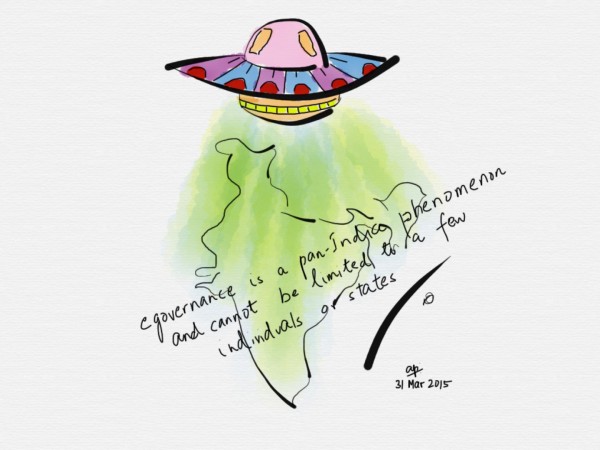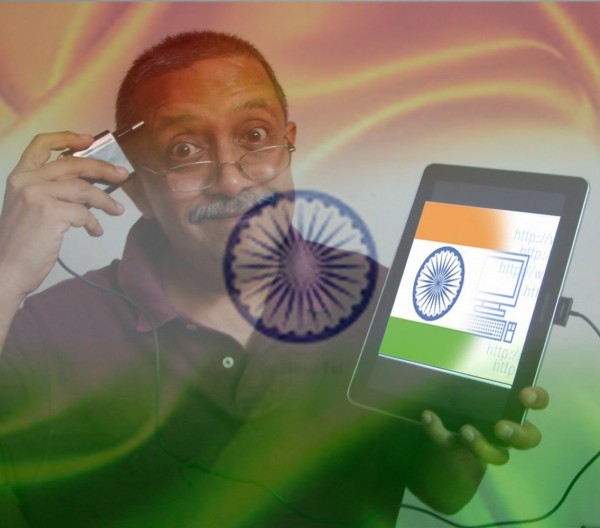Growth isn’t only economics and technology in a strategic alliance. It has everything to do with the physics of implementation, the physiology and the biology of proliferation, and the chemistry of valour. There is of course the geography or the contours of fiscal health and the history of mind-sets to consider when the target is national growth. It is true that any nation grows only when all contemporary growth parameters are nurtured and nourished… and so it is a wholesome convergence of all that I have mentioned that will be needed if growth is the vision of our strategists.
The vital question now is: What do all these factors ride on?
Well, they ride on bit-n-bytes. They ride on digital thermals. They are what some of us know as e-governance. So far as India is concerned, we know that here it is the middle class that “is rapidly expanding and creating opportunities for retail growth. Over the next 20 years, 3 billion people are on track to join the middle class in these growth markets, placing 5 billion of the world’s 8 billion people into this group.” A Nielsen study points out that “the Indian economy boasted a 9 percent boost in GDP during its 2007-2011 fiscal years, according to a recent report on its fast-moving consumer goods market. And with this new-found growth, demand for new technology has risen. Globally, intentions to buy new technology products (29%) in the third quarter of 2013 increased 4 percentage points compared to the second quarter, according to Nielsen’s Q3 2014 Global Consumer Confidence report.” These studies simply point out to the rising necessity of recognising the coming of age of the digital era for India. These figures, of course, will be vastly different in the more recent studies, once the statistics are made available… but we now know that over the past decade, new innovations have easily connected consumers around the globe — including more than ever those living in emerging markets such as Brazil, Russia, India, China and South Africa (also known as BRICS).
A digital India is a reality. But is e-governance as real as it is made out to be? How does India really go about managing e-governance to help it strengthen the digital dreams of the country? We really need to get under the skin of what are considered to be the four pillars of e-governance that were created to innovate for India, namely, Connectivity, Content, Capacity, and Capital or PPP… and go beyond conventional definitions and explore the truth as it is. Let us consider these four real-time features:
Micro-segment proliferation
e-omnipresence
Tech DNA
Brave start-ups
Micro-segment proliferation – E-governance isn’t a concept that works in isolation. It needs acceptance from people and departments all across the horizon. If a ministry has its offices in the Capital blowing the digital trumpet, it will be mere noise if the departments connected and controlled by it are not slowly adopting the same route. So the proliferation of the digital concept needs to be deep-rooted as well as deep-seated. What I mean is that this concept isn’t here as a make-shift arrangement… it is here to stay and so needs to be deep-seated. This may obviously seem a lot like the next part that I want to take up which is e-omnipresence… but it isn’t, as you will soon see.
e-omnipresence – All that I am trying to say is that it is both the public as well as the private enterprises where the digital fever must reign. E-governance isn’t something only for the government offices. The sooner we have tendering going online, for instance, the sooner we will have crossed another landmark in e-governance. This tendering that I mentioned, isn’t something that only organisations in bigger towns need to adopt… it should be adopted by all States and must not be limited to only the capitals or the larger townships. But then this can happen only if there is Tech DNA.
Tech DNA – All that I mean is that both micro-segment proliferation as well as e-omnipresence is possible only if the tech dna is set up correctly. Can we really dream e-governance if people and organisations are willing to adopt all the new technologies but technology carriers are either absent or misplaced? Let me explain. If offices are given all the computers they need but printer and scanner purchases are frowned upon, can e-adoption be complete? If hardware of all sort is made available but tech skill development goes slow, is e-governance going to jog? If we have skilled staff and all the necessary computers too but we lack a proper bandwidth of connectivity, you can only imagine the sort of chaos and confusion it is going to result in. Look, a digital India is possible only if the right Tech DNA is put in place.
Brave Start-ups – These are not the conventional start-ups that I am talking about. All I mean to say is that technology isn’t something that ever stops evolving and so there is stage when anyone can get up and say, ‘Hello! We have reached where we wanted to. Now we can stop adding any more technology and just be content to work with whatever we have.’ This is the sort of disastrous thought process that I am talking about… and obviously what it means is that the cycles of Micro-segment Proliferation, e-omnipresence, and Tech DNA must go on ceaselessly.
What really happens with e-governance?
Let me illustrate the advantages with illustrations and examples taken from real life:
The cab-driver looked up from his smartphone and asked me, ‘Sir, I have got this message that is asking me to SMS my Aadhar number and I’ll be able to feed it in the voter’s list without having to visit any office and without having to wait in a queue. I hope this is safe?’ I read the message and said, ‘Yes, it is. Go ahead and send the message.’ I could feel the impact of e-governance here.
My wife returned from her college one day and announced, ‘We now have a biometric machine installed. I’m so happy.’ Well, she was happy because now no lecturer or office staff would reach late and leave early as ‘this was such a drain on work speed and work accomplished’ because absence of people is what stops work from being completed. Moreover, attendance is now a dispassionate statistical truth where neither favouritism nor bullying would work and tardy record-keeping with the government is not going to cause any sort of problems with salary disbursement etc. This is another positive facet of e-governance.
A couple of months back I had to go to my LPG dealer and also visit the bank to ensure that my account as well as the Indane account were linked to my Aadhar number. He said that this would make sure that subsidy reached the right person and would lead to a fall in black-marketing of LPG cylinders. Well, here we have another great example of how e-governance in action is benefiting people.
When the government announced that even the poorest of poor will have a bank account that will be Aadhar linked and will also entitle the holder to a debit card, I said, ‘This is another way transactions are going to get more and more transparent.’ A victory for e-governance, of course.
Credit and Debit card transactions (even net banking) are being encouraged and this is another way of making sure that money unaccounted for will slowly become more and more difficult to keep and spend. Transparency in spending leads to a transparency in business transactions and thus reduce the load of unaccounted for money… this, in turn, just might transform people into more straightforward employees who shun bribes and kick-backs. Money trails become apparent with the advent of e-governance.
In conclusion
Growth is indeed like the chromosomes in our body but they travel on wheels of technology that we invent. Yes, we are the Gods of growth and we must strive to adopt technology without stopping or slowing. This is because the speed at which we research technology is anyway faster than the average speed at which we can adopt and understand its end-results. So we have only one way… improve digital skills for India and make e-governance the pivot and adoption of digital innovations a habit.
.
.
.
.
.

e-governance cannot be isolated to a few individuals or States… it needs to be a pan-India phenomenon
.
Arvind Passey
31 March 2015










8 comments
Sriram Raj says:
Apr 2, 2015
Nice Aravind Sir. One of the most interesting articles I have read from you
Arvind Passey says:
Apr 9, 2015
Thank you, Sriram… I do try my best to make every post interesting as well as insightful. I’m happy that I have succeeded in this one. 🙂
Gowtham says:
Apr 3, 2015
Very interesting post Arvind. I enjoyed reading it, especially the stories corresponding to the e-governance. Simple yet thought provoking!
My best wishes for the contest 😉
Arvind Passey says:
Apr 9, 2015
Thank you for your wishes… and yes, I loved the fact that you liked the post. Do keeping dropping by to read more. By the way, my articles are also published in ‘The Huffington Post’, ‘Business Insider’, ‘Marketing Buzzar’ etc…
sabina says:
Apr 5, 2015
Great article. Well documented. I love the last photograph as well. All the best for the contest.
Arvind Passey says:
Apr 9, 2015
Thanks a lot, Sabina. Well, there was a lot more that I wanted to write, but I left it all for another post another day.
Sammya Brata says:
Apr 11, 2015
Loved this one Sir. You are always innovative with your posts. What’s your take on these public citizen kiosks operating on the PPP model? Does it sound profitable? Even the idea of Tech DNA sounds cool, that’s perhaps e Governance 3.0 🙂 Drawing my experience in e-Governance, I’ll have to say that more of these vibrant ideas should come in. 🙂
Regards
Sammya
Arvind Passey says:
Apr 13, 2015
When it comes to the PPP model, it isn’t so much about profitability as much as it should be about the appropriateness and the necessity of a service. The aims of PPP are entirely different… though they are prone to be interpreted in so many ways. I think we still have a fair distance to go to reach the Tech DNA stage… but yes, you’re right about the need for dynamic ideas to flow in unimpeded.
Thanks for reaching out and reading this post… wanted to reply earlier but couldn’t as my attention was always diverted at the last moment. sorry about this late reply.